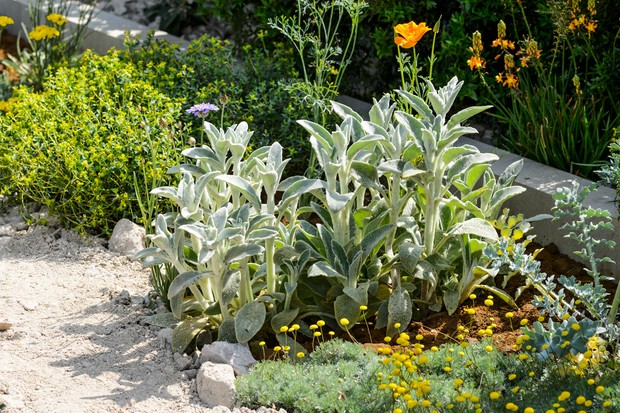
Lamb’s ear (Stachys byzantina) is a drought-tolerant perennial with silvery green, evergreen leaves that are covered in a fine coating of hairs, that makes them appear woolly. In summer it bears spikes of pink-purple flowers. It’s a popular choice for dry gardens, gravel gardens and rock gardens, and is also loved by the wool carder bee, a solitary bee that ‘cards’ the hairs from the leaves to make a soft nesting chamber into which she lays her eggs. You may spot male wool carder bees patrolling patches of lambs’ ear which they have claimed as their territory, and fighting off rivals and even bumblebees who venture too close.
How to grow lambs’ ear
Lamb’s ear is easy to grow and requires very little maintenance. Grow it in moist but well-drained soil in full sun to partial shade. Native to the Mediterranean, it’s extremely drought-tolerant once established. Cut back spent lamb’s ear flowers in autumn. There’s no need to feed lamb’s ear.
Where to grow lamb’s ear
Lamb’s ear growing as part of a garden border
Grow lamb’s ear in moist but well-drained soil in full sun to partial shade. Forming a low-growing mound of attractive foliage, topped in summer with flower spikes growing up to 1m in height, it’s perfect for the front to the middle of a border, and is commonly used as ground cover (some gardeners remove the flowers to concentrate on the foliage). It also works well in pots, where its leaves act as the perfect foil for different coloured plants.
How to plant lamb’s ear

Planting lamb’s ear
Plant lamb’s ear in moist but well-drained soil, in full sun. Dig a hole that’s the same depth as the plant pot. Firm around the rootball and water well.
Caring for lamb’s ear

Deadheading lamb’s ear
Lamb’s ear plant is a very low maintenance plant. Water only when conditions are really dry. There’s no need to feed the plants and deadhead spent blooms in autumn. Tidy up the foliage as and when you need to.
Propagating lamb’s ear

Harvesting seeds from lamb’s ear
Lamb’s ear can be propagated from seed but it’s easier to propagate by division in spring or autumn. Simply dig up the rootball and use a sharp spade or knife to divide it into two or three parts, ensuring a good section of roots is contained in all pieces, and replant them separately. Water thoroughly for the first couple of weeks, until each plant has established.
Growing lamb’s ear: pests and problem-solving
Lamb’s ear suffers from no pests or diseases. However, in damp soils or after heavy rain or too much water, the leaves can appear to ‘wilt’ and rot. Remove wilting or rotting leaves as soon as you see them, to stop the rot spreading to the rest of the plant, and reduce watering if you can. If drainage is an issue, you can dig up the plant and place a thick layer of grit at the bottom of the planting hole to aid drainage, while adding a layer of gravel beneath the leaves can reduce contact with the soil and help prevent future rotting.
Advice on buying lamb’s ear
- Ensure you have the correct growing conditons for lamb’s ear – moist soils can lead to wilting leaves and rotting
- Always check plants for signs of damage and disease, before planting
Where to buy lamb’s ear
Varieties of lamb’s ear to grow
1
Stachys byzantina ‘Silver Carpet’
Grown as a ground-cover plant, this variety forms a dense mat of silvery foliage and rarely flowers.
Height x Spread: 20cm x 45cm
2
Stachys byzantina ‘Big Ears’
Bears larger leaves than other varieties, as well as spikes of woolly, purple flowers from June to September. H x S: 60cm x 45cm
3
Stachys byzantina ‘Silky Fleece’
A dwarf variety, with tiny silvery leaves, and short flower spikes. H x S: 5cm x 30cm
